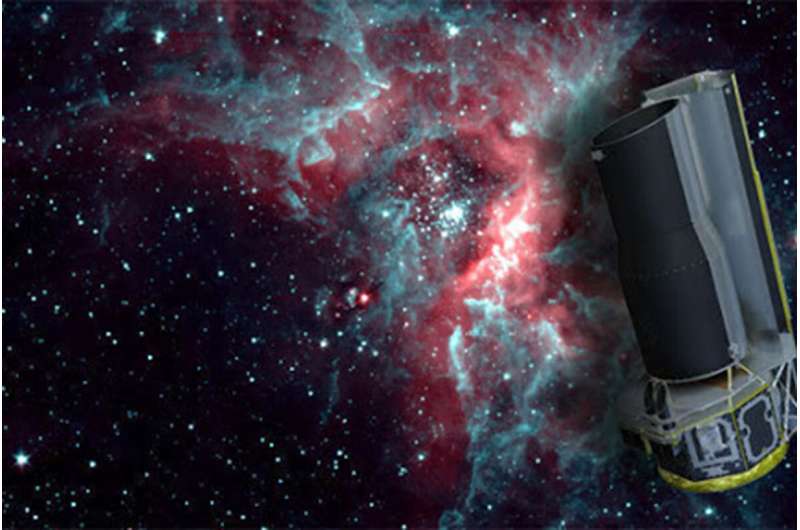The Spitzer Space Telescope made many important discoveries in the solar system during its 16 year-long mission. Credit: NASA/JPL-Caltech
To understand the significance of the Spitzer Space Telescope on the understanding of our solar system, think of what the steam engine meant for the industrial revolution.
A national team of scientists today published in the journal Nature Astronomy two papers that provide an inventory of the major discoveries made possible thanks to Spitzer and offer guidance on where the next generation of explorers should point the James Webb Space Telescope (JWST) when it launches in October 2021.
"The Spitzer Space Telescope made many important discoveries in the solar system during its 16 year-long mission, and it is important to capture the highlights of these with useful references for future scientists to use in their research," says Carey M. Lisse, from the Johns Hopkins Applied Physics Lab, lead author of one paper.
Lisse, a planetary astronomer, put together the team of 27 authors who penned the legacy papers. The authors were selected based on the significant discoveries they made using Spitzer during its 16-year mission. The team includes three University of Central Florida researchers, who offer suggestions for the next space telescope mission.
David Trilling, a planetary scientist and professor at Northern Arizona University, is the lead author on the second paper.
When Spitzer launched in 2003, it contained infrared detectors of unprecedented sensitivity, providing astronomers a never-before-possible look at the universe. Thanks to observations by Spitzer over the years, scientists gained new insights into, for example, the composition of comets, the icy surfaces of cold, distant bodies beyond Neptune, the heat radiation given off by asteroids, the extent of free-floating dust in the inner solar system, and the composition and properties of the atmospheres of Uranus and Neptune. Spitzer even managed to discover a new ring of Saturn. The much-delayed JWST, which will likewise study the infrared cosmos, is expected to build on the extensive results provided by Spitzer, including taking the next step in our study of the solar system.
UCF Professor Yan Fernandez, who specializes in comets, said the papers include some of the projects he is most proud off in his career. Fernandez is a co-author on both papers.
"I think these papers demonstrate the return on investment for Spitzer," Fernandez said. "These space telescopes are taxpayer-funded, after all. More philosophically, Spitzer has brought us closer to those big questions about why the solar system and Earth are here in the first place. Spitzer was not only great for the solar system, but it was great for studying exoplanets, great for studying planet formation, and great for studying star formation. All important to understand why our solar system turned out the way it did."
Noemí Pinilla-Alonso said astronomy is based on patience and collaboration. She studies Trans-Neptunian Objects at UCF's Florida Space Institute and contributed to the paper alongside institute post-doctoral scholar Estela Fernández-Valenzuela. Pinilla-Alonso is among a handful of scientists already guaranteed time on JWST once it is place. She is part of the team that will be calibrating the instrument from the ground.
"Answering one question takes the effort of multiple scientists or groups, each of them with a unique set of skills," Pinilla-Alonso says. "My contribution to this work is to provide the basic recipe of which ingredients are needed to build or cook an icy body in the solar system. And this is a key piece of information that is needed to answer questions such as how did the solar system form? How has it evolved to its actual state? How similar or different is our solar system from the long list, more than 3,000, of exoplanetary systems discovered?"
Fernandez-Valenzuela also studies Trans-Neptunian Objects and earlier this year held workshops to help scientists prepare successful proposals to obtain time on the JWST once NASA opens up the process.
"This work has helped us to understand what we could do with Spitzer data and how to use the JWST capabilities to shed light on issues that Spitzer could not answer," Fernández-Valenzuela says.
"Using Spitzer we have been able to detect specific materials that were impossible to detect from ground-based telescopes, due to the atmosphere, or using the Hubble Space Telescope," Fernández-Valenzuela says. "Now with JWST we will be able to obtain information on much fainter objects than is currently possible. I'm eager for that day as it will be a very important milestone for this research area. It will provide much more information on the formation of the outer solar system."
Spitzer was turned off in January 2020, 11 years beyond its prime mission.
"Spitzer was sensitive to infrared radiation, as opposed to visible light," Trilling says. "In many ways, Spitzer provided a view of the universe and of planetary bodies in our solar system that scientists had never seen before. This technological revolution produced new insights into the formation and evolution of our solar system."
More information: Carey Lisse et al. Spitzer's Solar System studies of comets, centaurs and Kuiper belt objects, Nature Astronomy (2020). DOI: 10.1038/s41550-020-01219-6
David E. Trilling et al. Spitzer's Solar System studies of asteroids, planets and the zodiacal cloud, Nature Astronomy (2020). DOI: 10.1038/s41550-020-01221-y
Journal information: Nature Astronomy
Provided by University of Central Florida
























